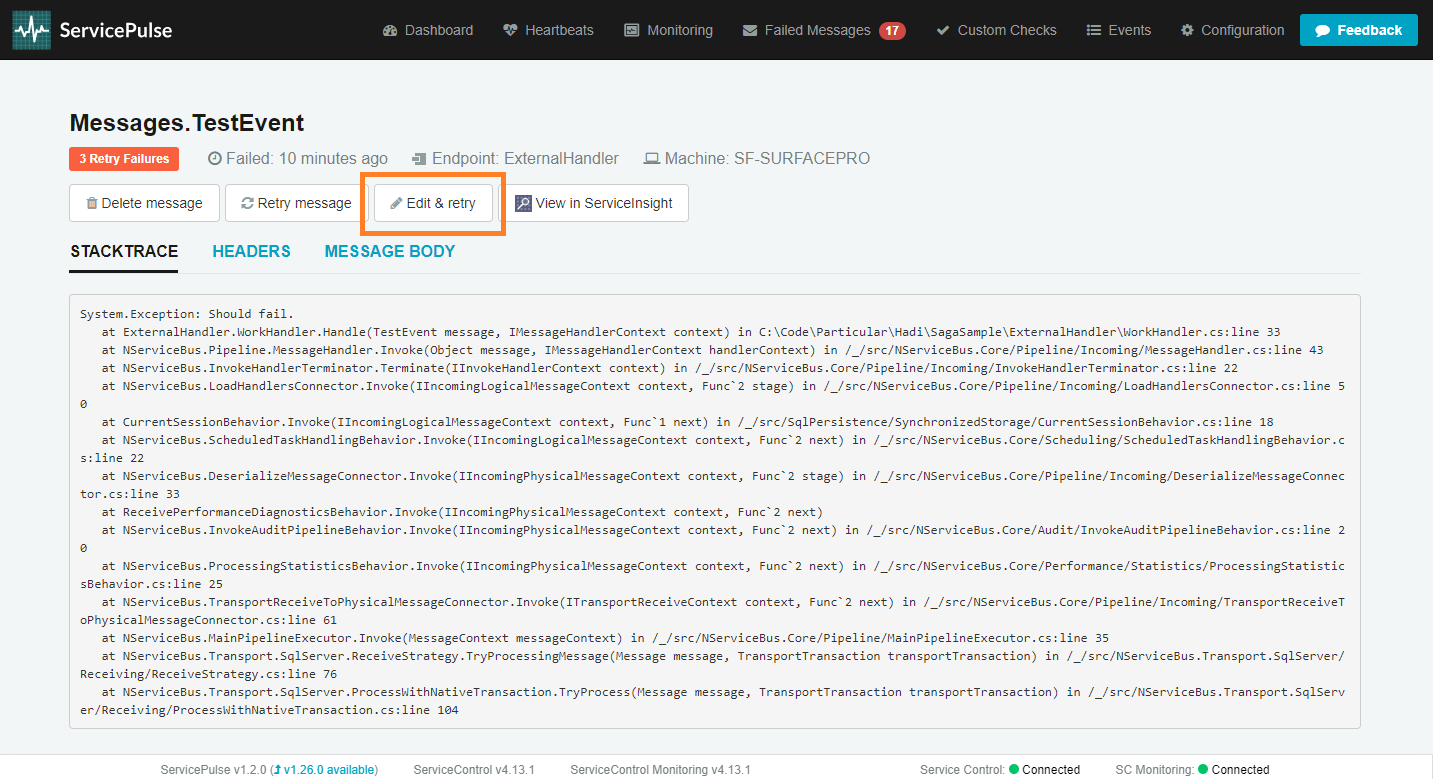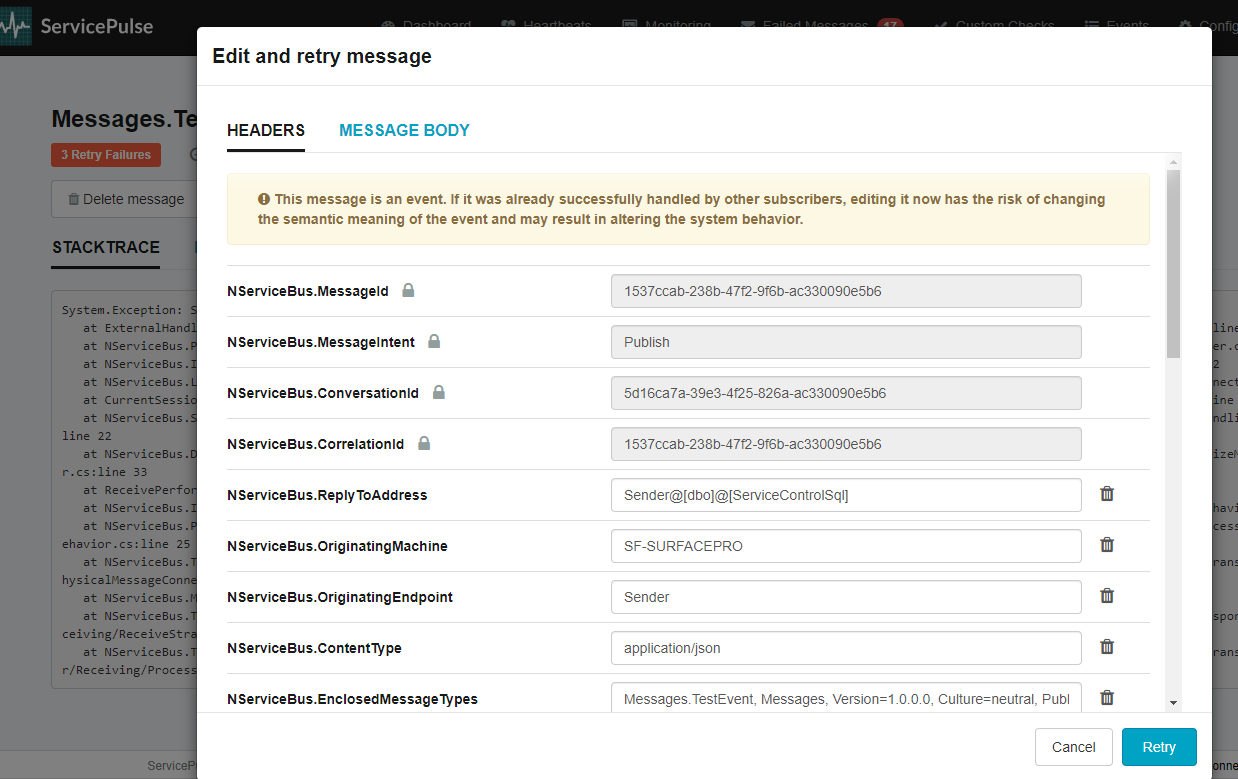If a message cannot be successfully retried it is possible to fix the malformed message prior to retrying it. Both the headers and the body of a message can be edited. This capability can be accessed when looking at an individual message.
This feature works in the following way:
- A copy of the failed message with a new message ID is created.
- The headers and body of the newly created copy can be edited.
- The copied message is dispatched, and the original failed message is marked as resolved.
Enabling the feature
Editing malformed messages is a potentially destructive operation, which if used improperly can have consequences that affect the correctness of the system. If a malformed message is edited improperly, it could still be processed successfully, without any way to undo the effects. The possible effects of editing a malformed message are system-specific and ServicePulse is unable to determine if a potential edit operation is safe for the system. Currently there is no way to limit failed message editing only to certain security groups or to specific message types.
System designers may prefer to disallow message editing in order to guarantee the correctness of the system. As a result, the message editing feature is currently considered experimental and is disabled by default.
Before enabling the feature, carefully evaluate possible use cases for editing malformed messages and consider alternative solutions for those use cases such as ServiceControl retry redirects, especially for use cases that are common and recurring. For help with alternatives for specific situations, contact Particular Support for assistance.
Editing malformed messages requires both ServiceControl 4.1.0+ and ServicePulse 1.21.0+.
The feature in ServicePulse is enabled via the configuration file for ServiceControl:
- Find the ServiceControl installation directory using ServiceControl Management Utility.
- Edit the ServiceControl configuration file
ServiceControl.with elevated privileges.exe. config - Add the following entry in the
<appSettings> <add key="ServiceControl/AllowMessageEditing" value="true" /> - Restart ServiceControl.
Headers
Headers on all failed messages can be edited using this feature. There are three categories of headers, each with different editing restrictions.
Locked headers: Headers that are critical to the operation of NServiceBus cannot be edited. These headers will have a lock image next to their name.
Sensitive headers: Headers that, when their values change, may result in unexpected or unwanted behavior are categorized as "Sensitive". When these headers are modified, the ⚠️ icon indicates their sensitive nature to the user.
Custom headers: Any headers that have not been been categorized as Locked or Sensitive will be fully editable. This will include headers created as part of a system customization. It is also possible to delete (and retrieve) these headers during the editing process. Once a message has been edited and retried, any deleted headers will be lost forever.
Editing the message body
Message bodies can be edited before they are retried. This is only possible for message bodies that are serialized using unencrypted JSON or XML.
Retrying edited messages
Retrying messages after editing the message headers can cause message processing failures and/or visualization issues in ServicePulse.
When retrying an edited message it is possible that the original failed message will have been resolved by another user, retried successfully by another user, or expired as part of the automated processes. In those scenarios, the new message will not be dispatched and the retry of the edited message will fail.
As soon as a message has been dispatched for retrying the originally failing message will be marked as resolved. If the retry message subsequently fails it will appear as a new failed message in the user interface. That new failed message will be marked as having been edited and also have a link to the original message.
Retrying a message, regardless whether it is processed correctly or not, dispatches also a MessageEditedAndRetried event. That event includes an ID of the original message.
The copy of the failed message receives a new message ID. The copied message is related to the original failed message through the NServiceBus. header that is set to the ID of the original message. The copy carries also the same NServiceBus. as the original.
Limitations and restrictions
A failed message must not have been resolved by a user, successfully retried, or expired as part of the automated processes for edit and retry to function.
The bodies of messages with encrypted properties cannot be edited.
The edited message will be assigned a new message ID before dispatching. The new message ID is automatically generated and is a GUID stored as a string in the edited message's headers.
Resolving a failed message doesn't publish any ServiceControl events.

